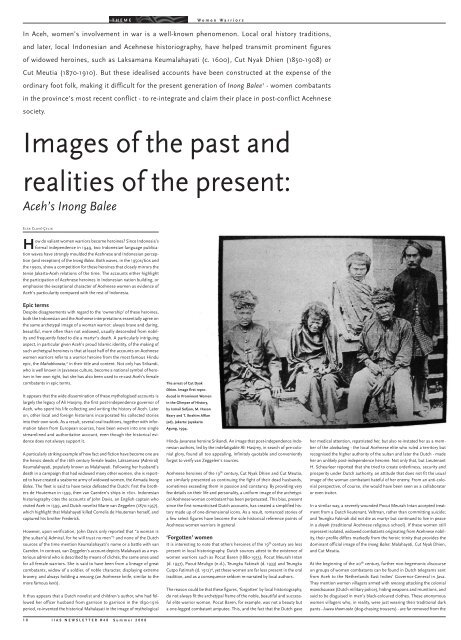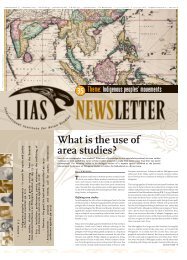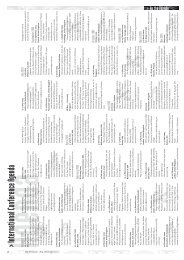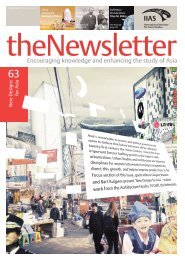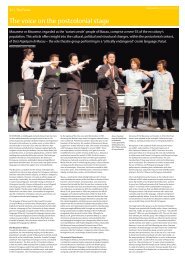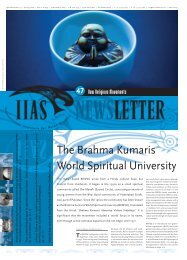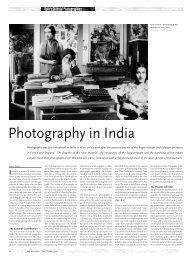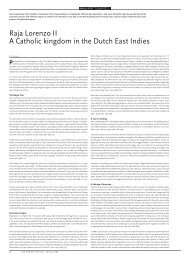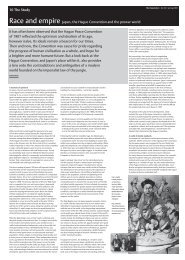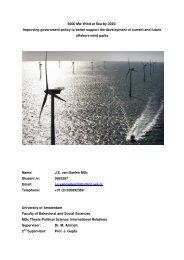Sex, love and revolution - IIAS
Sex, love and revolution - IIAS
Sex, love and revolution - IIAS
Create successful ePaper yourself
Turn your PDF publications into a flip-book with our unique Google optimized e-Paper software.
T H E M E W o m e n W a r r i o r s<br />
In Aceh, women’s involvement in war is a well-known phenomenon. Local oral history traditions,<br />
<strong>and</strong> later, local Indonesian <strong>and</strong> Acehnese historiography, have helped transmit prominent figures<br />
of widowed heroines, such as Laksamana Keumalahayati (c. 1600), Cut Nyak Dhien (1850-1908) or<br />
Cut Meutia (1870-1910). But these idealised accounts have been constructed at the expense of the<br />
ordinary foot folk, making it difficult for the present generation of Inong Balee 1 - women combatants<br />
in the province’s most recent conflict - to re-integrate <strong>and</strong> claim their place in post-conflict Acehnese<br />
society.<br />
Images of the past <strong>and</strong><br />
realities of the present:<br />
Aceh’s Inong Balee<br />
Elsa Clavé-Çelik<br />
How do valiant women warriors become heroines? Since Indonesia’s<br />
formal independence in 1949, two Indonesian-language publication<br />
waves have strongly moulded the Acehnese <strong>and</strong> Indonesian perception<br />
(<strong>and</strong> reception) of the Inong Balee. Both waves, in the 1950s/60s <strong>and</strong><br />
the 1990s, show a competition for these heroines that closely mirrors the<br />
tense Jakarta-Aceh relations of the time. The accounts either highlight<br />
the participation of Acehnese heroines in Indonesian nation building, or<br />
emphasise the exceptional character of Acehnese women as evidence of<br />
Aceh’s particularity compared with the rest of Indonesia.<br />
Epic terms<br />
Despite disagreements with regard to the ‘ownership’ of these heroines,<br />
both the Indonesian <strong>and</strong> the Acehnese interpretations essentially agree on<br />
the same archetypal image of a woman warrior: always brave <strong>and</strong> daring,<br />
beautiful, more often than not widowed, usually descended from nobility<br />
<strong>and</strong> frequently fated to die a martyr’s death. A particularly intriguing<br />
aspect, in particular given Aceh’s proud Islamic identity, of the making of<br />
such archetypal heroines is that at least half of the accounts on Acehnese<br />
women warriors refer to a warrior heroine from the most famous Hindu<br />
epic, the Mahabharata, 2 in their title <strong>and</strong> content. Not only has Srik<strong>and</strong>i,<br />
who is well known in Javanese culture, become a national symbol of heroism<br />
in her own right, but she has also been used to re-cast Aceh’s female<br />
combatants in epic terms.<br />
It appears that the wide dissemination of these mythologised accounts is<br />
largely the legacy of Ali Hasjmy, the first post-independence governor of<br />
Aceh, who spent his life collecting <strong>and</strong> writing the history of Aceh. Later<br />
on, other local <strong>and</strong> foreign historians incorporated his collected stories<br />
into their own work. As a result, several oral traditions, together with information<br />
taken from European sources, have been woven into one single<br />
streamlined <strong>and</strong> authoritative account, even though the historical evidence<br />
does not always support it.<br />
A particularly striking example of how fact <strong>and</strong> fiction have become one are<br />
the heroic deeds of the 16th century female leader, Laksamana (Admiral)<br />
Keumalahayati, popularly known as Malahayati. Following her husb<strong>and</strong>’s<br />
death in a campaign that had widowed many other women, she is reported<br />
to have created a seaborne army of widowed women, the Armada Inong<br />
Balee. The fleet is said to have twice defeated the Dutch: first the brothers<br />
de Houteman in 1599, then van Caerden’s ships in 1601. Indonesian<br />
historiography cites the accounts of John Davis, an English captain who<br />
visited Aceh in 1599, <strong>and</strong> Dutch novelist Marie van Zeggelen (1870-1957),<br />
which highlight that Malahayati killed Cornelis de Houteman herself, <strong>and</strong><br />
captured his brother Frederick.<br />
However, upon verification, John Davis only reported that “a woman is<br />
[the sultan’s] Admiral, for he will trust no men” 3 <strong>and</strong> none of the Dutch<br />
sources of the time mention Keumalahayati’s name or a battle with van<br />
Caerden. In contrast, van Zeggelen’s account depicts Malahayati as a mysterious<br />
admiral who is described by means of clichés, the same ones used<br />
for all female warriors. She is said to have been from a lineage of great<br />
combatants, widow of a soldier, of noble character, displaying extreme<br />
bravery, <strong>and</strong> always holding a rencong (an Acehnese knife, similar to the<br />
more famous keris).<br />
It thus appears that a Dutch novelist <strong>and</strong> children’s author, who had followed<br />
her officer husb<strong>and</strong> from garrison to garrison in the 1890-1916<br />
period, re-invented the historical Mahalayati in the image of mythological<br />
The arrest of Cut Dyak<br />
Dhien. Image first reproduced<br />
in Prominent Women<br />
in the Glimpse of History,<br />
by Ismail Sofyan, M. Hasan<br />
Basry <strong>and</strong> T. Ibrahim Alfian<br />
(ed). Jakarta: Jayakarta<br />
Agung, 1994.<br />
Hindu-Javanese heroine Srik<strong>and</strong>i. An image that post-independence Indonesian<br />
authors, led by the indefatigable Ali Hasjmy, in search of pre-colonial<br />
glory, found all too appealing, infinitely quotable <strong>and</strong> conveniently<br />
forgot to verify van Zeggelen’s sources.<br />
Acehnese heroines of the 19 th century, Cut Nyak Dhien <strong>and</strong> Cut Meutia,<br />
are similarly presented as continuing the fight of their dead husb<strong>and</strong>s,<br />
sometimes exceeding them in passion <strong>and</strong> constancy. By providing very<br />
few details on their life <strong>and</strong> personality, a uniform image of the archetypical<br />
Acehnese woman combatant has been perpetuated. This bias, present<br />
since the first romanticised Dutch accounts, has created a simplified history<br />
made up of one-dimensional icons. As a result, romanced stories of<br />
a few select figures have become the sole historical reference points of<br />
Acehnese women warriors in general<br />
‘Forgotten’ women<br />
It is interesting to note that others heroines of the 19 th century are less<br />
present in local historiography. Dutch sources attest to the existence of<br />
women warriors such as Pocut Baren (1880-1933), Pocut Meurah Intan<br />
(d. 1937), Pocut Meuligo (n.d.), Teungku Fakinah (d. 1933) <strong>and</strong> Teungku<br />
Cutpo Fatimah (d. 1912) 4 , yet these women are far less present in the oral<br />
tradition, <strong>and</strong> as a consequence seldom re-narrated by local authors.<br />
The reason could be that these figures, ‘forgotten’ by local historiography,<br />
do not always fit the archetypal frame of the noble, beautiful <strong>and</strong> successful<br />
elite warrior woman. Pocut Baren, for example, was not a beauty but<br />
a one-legged combatant amputee. This, <strong>and</strong> the fact that the Dutch gave<br />
her medical attention, repatriated her, but also re-instated her as a member<br />
of the uleebalang - the local Acehnese elite who ruled a territory but<br />
recognised the higher authority of the sultan <strong>and</strong> later the Dutch - made<br />
her an unlikely post-independence heroine. Not only that, but Lieutenant<br />
H. Scheurleer reported that she tried to create orderliness, security <strong>and</strong><br />
prosperity under Dutch authority, an attitude that does not fit the usual<br />
image of the woman combatant hateful of her enemy. From an anti-colonial<br />
perspective, of course, she would have been seen as a collaborator<br />
or even traitor.<br />
In a similar way, a severely wounded Pocut Meurah Intan accepted treatment<br />
from a Dutch lieutenant, Veltman, rather than committing suicide;<br />
<strong>and</strong> Teungku Fakinah did not die as martyr but continued to live in peace<br />
in a dayah (traditional Acehnese religious school). If these women still<br />
represent isolated, widowed combatants originating from Acehnese nobility,<br />
their profile differs markedly from the heroic trinity that provides the<br />
dominant official image of the Inong Balee: Malahayati, Cut Nyak Dhien,<br />
<strong>and</strong> Cut Meutia.<br />
At the beginning of the 20 th century, further non-hegemonic discourse<br />
on groups of women combatants can be found in Dutch telegrams sent<br />
from Aceh to the Netherl<strong>and</strong>s East Indies’ Governor-General in Java.<br />
They mention women villagers armed with rencong attacking the colonial<br />
marechaussee (Dutch military police), hiding weapons <strong>and</strong> munitions, <strong>and</strong><br />
said to be disguised in men’s black-coloured clothes. These anonymous<br />
women villagers who, in reality, were just wearing their traditional dark<br />
pants - luweu tham asèe (dog-chasing trousers) - are far removed from the<br />
1 0<br />
I I A S N E W S L E T T E R # 4 8 S u m m e r 2 0 0 8


